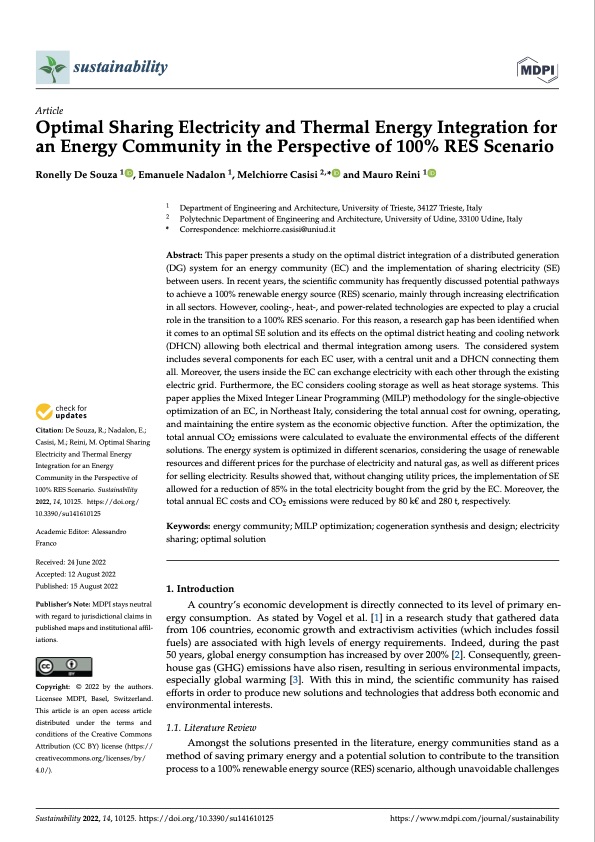
PDF Publication Title:
Text from PDF Page: 001
sustainability Article Optimal Sharing Electricity and Thermal Energy Integration for an Energy Community in the Perspective of 100% RES Scenario Ronelly De Souza 1 , Emanuele Nadalon 1, Melchiorre Casisi 2,* and Mauro Reini 1 Citation: De Souza, R.; Nadalon, E.; Casisi, M.; Reini, M. Optimal Sharing Electricity and Thermal Energy Integration for an Energy Community in the Perspective of 100% RES Scenario. Sustainability 2022,14,10125. https://doi.org/ 10.3390/su141610125 Academic Editor: Alessandro Franco Received: 24 June 2022 Accepted: 12 August 2022 Published: 15 August 2022 Publisher’s Note: MDPI stays neutral with regard to jurisdictional claims in published maps and institutional affil- iations. Copyright: © 2022 by the authors. Licensee MDPI, Basel, Switzerland. This article is an open access article distributed under the terms and conditions of the Creative Commons Attribution (CC BY) license (https:// creativecommons.org/licenses/by/ 4.0/). 1 2 Abstract: This paper presents a study on the optimal district integration of a distributed generation (DG) system for an energy community (EC) and the implementation of sharing electricity (SE) between users. In recent years, the scientific community has frequently discussed potential pathways to achieve a 100% renewable energy source (RES) scenario, mainly through increasing electrification in all sectors. However, cooling-, heat-, and power-related technologies are expected to play a crucial role in the transition to a 100% RES scenario. For this reason, a research gap has been identified when it comes to an optimal SE solution and its effects on the optimal district heating and cooling network (DHCN) allowing both electrical and thermal integration among users. The considered system includes several components for each EC user, with a central unit and a DHCN connecting them all. Moreover, the users inside the EC can exchange electricity with each other through the existing electric grid. Furthermore, the EC considers cooling storage as well as heat storage systems. This paper applies the Mixed Integer Linear Programming (MILP) methodology for the single-objective optimization of an EC, in Northeast Italy, considering the total annual cost for owning, operating, and maintaining the entire system as the economic objective function. After the optimization, the total annual CO2 emissions were calculated to evaluate the environmental effects of the different solutions. The energy system is optimized in different scenarios, considering the usage of renewable resources and different prices for the purchase of electricity and natural gas, as well as different prices for selling electricity. Results showed that, without changing utility prices, the implementation of SE allowed for a reduction of 85% in the total electricity bought from the grid by the EC. Moreover, the total annual EC costs and CO2 emissions were reduced by 80 k€ and 280 t, respectively. Keywords: energy community; MILP optimization; cogeneration synthesis and design; electricity sharing; optimal solution 1. Introduction A country’s economic development is directly connected to its level of primary en- ergy consumption. As stated by Vogel et al. [1] in a research study that gathered data from 106 countries, economic growth and extractivism activities (which includes fossil fuels) are associated with high levels of energy requirements. Indeed, during the past 50 years, global energy consumption has increased by over 200% [2]. Consequently, green- house gas (GHG) emissions have also risen, resulting in serious environmental impacts, especially global warming [3]. With this in mind, the scientific community has raised efforts in order to produce new solutions and technologies that address both economic and environmental interests. 1.1. Literature Review Amongst the solutions presented in the literature, energy communities stand as a method of saving primary energy and a potential solution to contribute to the transition process to a 100% renewable energy source (RES) scenario, although unavoidable challenges Department of Engineering and Architecture, University of Trieste, 34127 Trieste, Italy Polytechnic Department of Engineering and Architecture, University of Udine, 33100 Udine, Italy * Correspondence: melchiorre.casisi@uniud.it Sustainability 2022, 14, 10125. https://doi.org/10.3390/su141610125 https://www.mdpi.com/journal/sustainabilityPDF Image | Optimal Sharing Electricity and Thermal Energy

PDF Search Title:
Optimal Sharing Electricity and Thermal EnergyOriginal File Name Searched:
sustainability-14-10125-v2.pdfDIY PDF Search: Google It | Yahoo | Bing
Turbine and System Plans CAD CAM: Special for this month, any plans are $10,000 for complete Cad/Cam blueprints. License is for one build. Try before you buy a production license. More Info
Waste Heat Power Technology: Organic Rankine Cycle uses waste heat to make electricity, shaft horsepower and cooling. More Info
All Turbine and System Products: Infinity Turbine ORD systems, turbine generator sets, build plans and more to use your waste heat from 30C to 100C. More Info
CO2 Phase Change Demonstrator: CO2 goes supercritical at 30 C. This is a experimental platform which you can use to demonstrate phase change with low heat. Includes integration area for small CO2 turbine, static generator, and more. This can also be used for a GTL Gas to Liquids experimental platform. More Info
Introducing the Infinity Turbine Products Infinity Turbine develops and builds systems for making power from waste heat. It also is working on innovative strategies for storing, making, and deploying energy. More Info
Need Strategy? Use our Consulting and analyst services Infinity Turbine LLC is pleased to announce its consulting and analyst services. We have worked in the renewable energy industry as a researcher, developing sales and markets, along with may inventions and innovations. More Info
Made in USA with Global Energy Millennial Web Engine These pages were made with the Global Energy Web PDF Engine using Filemaker (Claris) software.
Sand Battery Sand and Paraffin for TES Thermo Energy Storage More Info
| CONTACT TEL: 608-238-6001 Email: greg@infinityturbine.com | RSS | AMP |